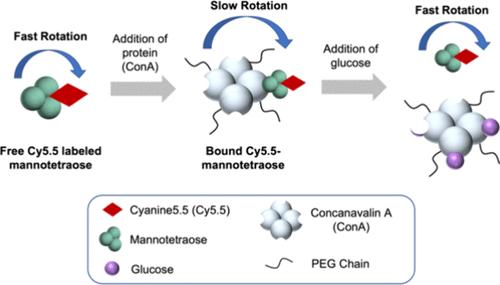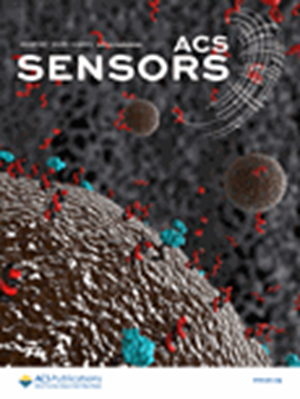计算模型辅助开发非酶促性荧光葡萄糖传感测定法
IF 8.2
1区 化学
Q1 CHEMISTRY, ANALYTICAL
引用次数: 0
摘要
在这种完全可注射的非酶葡萄糖生物传感器设计中采用了深红色荧光,使光线更好地穿透皮肤,尤其是深肤色皮肤。在这项工作中,开发了一种新方法来合成 Cy5.5 标记的甘露糖共轭物(Cy5.5-甘露双糖、Cy5.5-甘露三糖和 Cy5.5-甘露四糖),作为竞争性结合试验中的荧光竞争配体,而蛋白质 Concanavalin A 则作为识别分子。利用荧光各向异性(FA)数据建立了一个计算模型,以确定测定成分的最佳浓度比,从而在生理范围内进行灵敏的葡萄糖测量。通过 FA 测量三种 Cy5.5 标记的甘露糖共轭物的葡萄糖反应,实验验证了该模型,Cy5.5-甘露四糖在生理范围内对葡萄糖的反应最为灵敏。所开发的方法可广泛应用于各种市售荧光染料,并为使用非酶测定法测量葡萄糖提供了机会。本文章由计算机程序翻译,如有差异,请以英文原文为准。

Computational Model-Assisted Development of a Nonenzymatic Fluorescent Glucose-Sensing Assay
Deep-red fluorescence was implemented in this fully injectable, nonenzymatic glucose biosensor design to allow for better light penetration through the skin, particularly for darker skin tones. In this work, a novel method was developed to synthesize Cy5.5 labeled mannose conjugates (Cy5.5-mannobiose, Cy5.5-mannotriose, and Cy5.5-mannotetraose) to act as the fluorescent competing ligand in a competitive binding assay with the protein Concanavalin A acting as the recognition molecule. Using fluorescence anisotropy (FA) data, a computational model was developed to determine optimal concentration ratios of the assay components to allow for sensitive glucose measurements within the physiological range. The model was experimentally validated by measuring the glucose response via FA of the three Cy5.5-labeled mannose conjugates synthesized with Cy5.5-mannotetraose demonstrating the most sensitive response to glucose across the physiological range. The developed method may be broadly applied to a vast range of commercially available fluorescent dyes and opens up opportunities for glucose measurements using nonenzymatic assays.
求助全文
通过发布文献求助,成功后即可免费获取论文全文。
去求助
来源期刊

ACS Sensors
Chemical Engineering-Bioengineering
CiteScore
14.50
自引率
3.40%
发文量
372
期刊介绍:
ACS Sensors is a peer-reviewed research journal that focuses on the dissemination of new and original knowledge in the field of sensor science, particularly those that selectively sense chemical or biological species or processes. The journal covers a broad range of topics, including but not limited to biosensors, chemical sensors, gas sensors, intracellular sensors, single molecule sensors, cell chips, and microfluidic devices. It aims to publish articles that address conceptual advances in sensing technology applicable to various types of analytes or application papers that report on the use of existing sensing concepts in new ways or for new analytes.
 求助内容:
求助内容: 应助结果提醒方式:
应助结果提醒方式:


